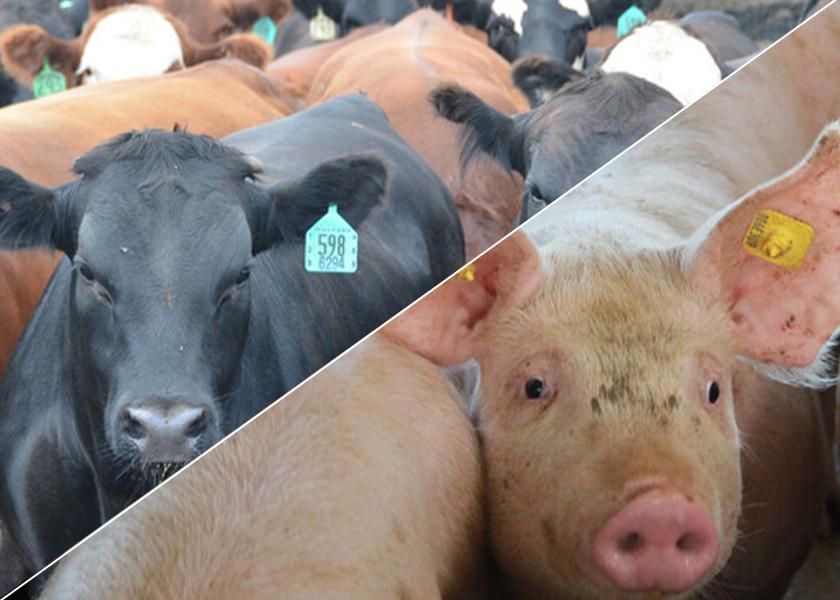Livestock Analysis | January 6, 2022

Price action: February lean hog futures rose 67.5 cents to $82.95, the highest close since Dec. 29.
Fundamental analysis: Hog futures sustained yesterday’s strong rebound, with February and April contracts leading gains amid strengthening cash fundamentals. The next CME lean hog index is expected to drop 30 cents, to $73.57, but the benchmark remains near the highest levels since mid-November. Bulls may believe a $6.42 morning jump in pork cutout values, to $90.28, will prove more sustainable than recent morning upswings that disappeared by the end of the day. Also, concern appeared to be easing over potential for packing plant shutdowns due to the Omicron coronavirus variant.
Traders probably aren’t paying a great deal of attention to the moderate increase in the four-day slaughter total of 1.853 million head, which is down 32,000 head, or 1.7%, from the comparable week-ago figure. That’s because the weekend total is the real key to ultimate weekly results. We’re still looking for a huge weekly figure, simply because the results for the two prior holiday-shortened weeks were so low. We see little reason to think the weekly total won’t fall at least 6.0% below the comparable year-ago total, as implied by last month’s Hogs and Pigs report.
Technical analysis: Bulls still own the technical advantage, especially in the summer contracts, which posted fresh highs again today. February futures gapped above resistance at the 10-day average near $82.41, but bulls have to be somewhat concerned they could only sustain a portion of the early push to the daily high at $84.05 and had to watch the contract post a low-range close.
Support at the 10-day moving average is backed by the 40-day moving average near $81.22, then by Tuesday’s low at $80.00. Bears would be targeting the Dec. 8 low at $75.35 if they were able to penetrate that short-term support. Today’s high at $84.05 represents initial resistance, with backing from last week’s high at $84.65. A close above that level would again have bulls targeting the October top at $87.475.
What to do: Get current with feed advice.
Hedgers: You currently have all risk in the cash market.
Feed needs: You are hand-to-mouth on corn-for-feed and soybean meal needs. Wait on price pullbacks to extend coverage.
Price action: February live cattle futures rose 10 cents to $137.35, after falling earlier to $136.375, the lowest intraday price since $135.95 on Dec. 21. March feeder cattle rose $1.10 to $167.275.
Fundamental analysis: Live cattle futures posted a gain for the first day in the past six as continued strength in the wholesale beef market helped the market find support despite eroding cash values. Choice cutout values rose $1.10 early today to $268.03, the highest daily average since Dec. 7, while Select gained 55 cents to $260.16. The wholesale market’s gradual climb over the past month suggests retail demand is improving after record prices last fall turned many consumers away from beef.
Futures’ upside may be limited by a weakening cash market and lagging slaughter rate that’s raised concern over a potential backlog of animals. Futures recent slide appears to have prompted some feedlots to sell at prices $1.00 to $2.00 below last week’s levels. Live steers averaged $138.71 through midweek, down from last week’s average of $139.59. Packers slaughtered an estimated 450,000 head of cattle so far this week, down 25,000, or 5.3%, from the same period last week and down from 467,000 for the comparable period in 2021, according to USDA.
Earlier today, USDA reported a net reduction of 3,900 MT in U.S. beef sales for the week ended Dec. 30, a marketing-year low and a drop from net sales of 6,300 MT the previous week. Reductions arose primarily from South Korea (2,300 MT), China (1,200 MT) and Japan (400 MT).
Technical analysis: Live cattle futures technical have slipped as prices fell over the past week, though the market may has found support around today’s February futures low, which is just above the 100-day moving average around $136.20. Further support is seen at the December low of $135.50. Key upside resistance levels include the 20- and 50-day moving averages around $138.20 and $137.75, respectively.
What to do: Short-term protective hedges for fed cattle producers may be needed if recent lows are violated.
Hedgers: Carry all risk in the cash market for now.
Feed needs: You are hand-to-mouth on corn-for-feed and soybean meal needs. Wait on price pullbacks to extend coverage.






